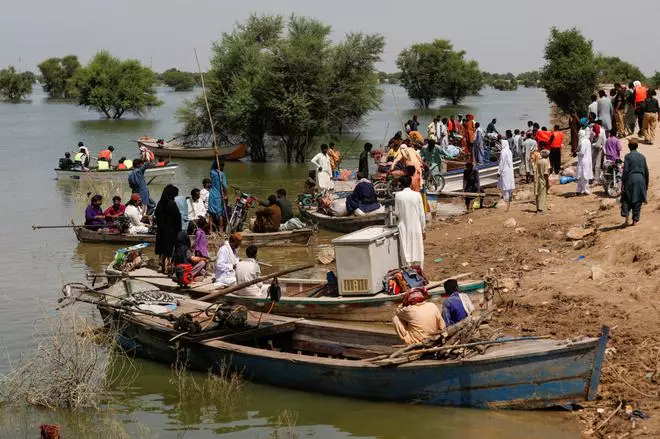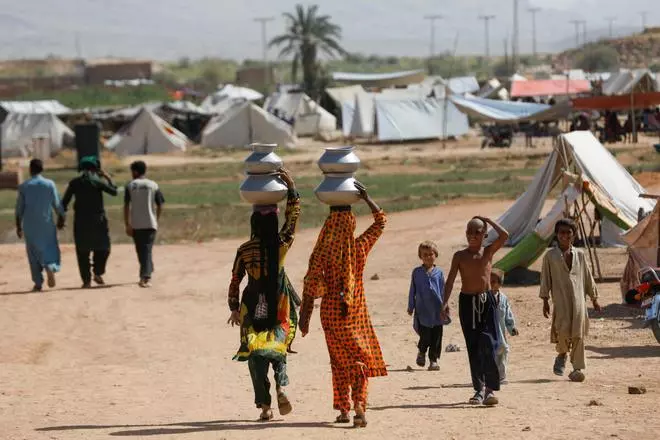An international team of leading climate scientists as part of the World Weather Attribution group has conducted a rapid attribution analysis to determine that Pakistan’s wettest August since 1961 is the result of “human-caused climate change”, which likely increased the intensity of the rain which flooded large parts of the neighbouring country.
According to the Pakistan government, at least 33 million people have been affected by the unprecedented rains, floods and impacts such as landslides. About 1,100 people lost their lives due to nature’s fury, which has damaged infrastructure, homes, agricultural lands and over seven lakh livestock.
Uncertainties in results

Children, who became displaced, play as their families take refuge in a camp, following rains and floods during the monsoon season in Sehwan, Pakistan September 15, 2022. REUTERS
The World Meteorological Organization (WMO), releasing the analysis during the weekend, said extreme rainfall in Pakistan increased by 50-75 per cent. “Some climate models suggest this increase could be entirely due to human-caused climate change, although there are considerable uncertainties in the results,” it said.
The Pakistan Meteorological Department said the national rainfall in August was 243 per cent above average. “In Balochistan, the rainfall was 590 per cent excess and in Sindh 726 per cent, according to the monthly report. The Indus river, which runs the length of the country, burst its banks across thousands of sq km, while the intense local rainfall also led to urban flash floods, landslides and glacial lake outburst floods,” the WMO said.
In view of the climate change impact, scientists are unable to simulate monsoon rainfall through modern climate models in the Indus river basin. This is because the region is located at the western edge of the monsoon and its rainfall pattern is extremely variable from year to year.
In line with IPCC assessments

Flood victims use boats to reach their villages, following rains and floods during the monsoon season in Sehwan, Pakistan, September 16, 2022. REUTERS
“Consequently, they could not quantify the influence of climate change as accurately as has been possible in other studies of extreme weather events, such as heatwaves and heavy rainfall in areas with less variability and more reliable models,” the WMO said.
For a period of five days, some models suggest that climate change increased the total rainfall in Sindh and Balochistan by up to 50 per cent. This is in line with recent Intergovernmental Panel on Climate Change (IPCC) assessments projecting more intense rains in the region. Historical weather records show that these heavy rainfall episodes have increased 75 per cent in the region in the last few decades, it said.
“There were large uncertainties in climate modelling of maximum 60-day rainfall in the Indus basin, meaning the scientists were not able to estimate the influence of climate change on this aspect of the rainfall,” the WMO said.
The organisation quoted Friederike Otto, Senior Lecturer in Climate Science at the Grantham Institute-Climate Change and the Environment, Imperial College London, as saying: “What we saw in Pakistan is exactly what climate projections have been predicting for years… our own analysis also shows clearly that further warming will make these heavy rainfall episodes even more intense.”
While appealing for relief from the global community, Ahsan Iqbal, Pakistan Minister for Planning, said the country’s contribution to the overall carbon footprint is negligible, but it is still among the top ten nations that are vulnerable to climate change.
Heatwave during summer

Displaced women walk to their tents in a camp with water pots on their head , following rains and floods during the monsoon season in Sehwan, Pakistan, September 16, 2022. REUTERS
During March-May this year, Pakistan was gripped by a devastating heatwave, which impacted water supplies, health, agricultural output and the economy, and caused rapid glacier melt. A rapid attribution survey said climate change made extreme heat 30 times more likely. India, too, went through a similar heatwave that damaged its wheat crops.
The WMO said Pakistan received the equivalent of 2.9 times the national 30-year average rainfall in August, with almost every part of the country receiving showers. The surprising aspect of this was Sindh and Balochistan receiving little rainfall during this period but were left experiencing extremely heavy precipitation.
The recent flooding in north Pakistan, especially in the mountainous Khyber Pakhtunkhwa province, threatens to aggravate the flood crisis.
The WMO said the ongoing disaster demonstrates once again the need for climate change mitigation and adaptation. The damage has resulted in the United Nations Office for the Coordination of Humanitarian Affairs appealing for $160.3 million in aid to help victims.





Comments
Comments have to be in English, and in full sentences. They cannot be abusive or personal. Please abide by our community guidelines for posting your comments.
We have migrated to a new commenting platform. If you are already a registered user of TheHindu Businessline and logged in, you may continue to engage with our articles. If you do not have an account please register and login to post comments. Users can access their older comments by logging into their accounts on Vuukle.